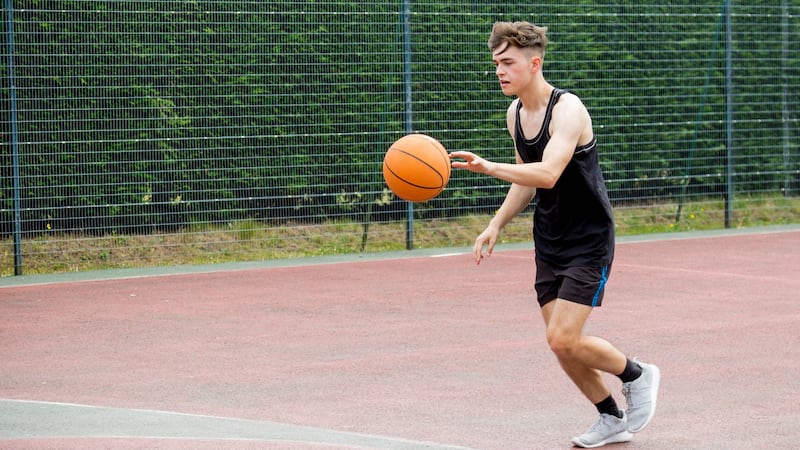However, when socio-economic situations are taken into account, "11 per cent of 17 and 18 year olds from high-income households report having a long-standing illness or disability compared with 17 per cent from low-income households", explains Dr Cathal McCrory, psychologist and associate professor at Trinity College Dublin.
With socio-economics also affecting the types of food our teenagers are likely to consume, Dr McCrory says that while “the introduction of the recent sugar tax may lead to a reduction in unhealthy food consumption, strategies are also needed on the other side to encourage consumption of nutritive-dense foods.
“Education is also important as many people might lack the knowledge and skills required to prepare a nutritionally balanced meal,” he says.
While there is a decline in physical activity levels among boys and girls as they transition from middle-childhood into adolescence, the decline is less pronounced among teenage boys. By the time boys reach 17/18, they average about four hours moderate to vigorous physical activity per week, compared with three hours among 17/18 year old girls.
Socio-economic status
“Features of the neighbourhood may contribute to some of the differences we see in physical activity levels by socio-economic status,” Dr McCrory says.
“Neighbourhoods can modify children’s physical activity participation through structural characteristics such as the provision of parks and green spaces, and design features such as neighbourhood walkability and cycle lanes, which may increase opportunities to be active; and through compositional characteristics, including social cohesion and the prevailing social climate, which may influence perceptions of the safety of the neighbourhood environment.
The teenage years are perhaps the most challenging stage of childhood
The differences in socio-economic status can be seen when we look at the percentage impact on various aspects of children’s health. “It has been estimated that if all children had the same start in life as the most socially advantaged, this would lead to a 24 per cent reduction in the incidence of low birth-weight, a 41 per cent reduction in long-standing illness or disability, a 27 per cent reduction in asthma prevalence and a 54 per cent reduction in conduct disorders,” Dr McCrory explains.
The teenage years are perhaps the most challenging stage of childhood as the transition from child to adult occurs alongside the many physical and emotional changes that accompany puberty. So how can we best look after our teenage boys’ overall health and wellbeing as they navigate this stage of their lives.
1) Nutrition
"Studies have found that boys tend to enter puberty later than girls, between the ages of 10-15 years. The increased appetite of teenage boys is directly reflective of their puberty growth spurt and whilst parents may often find this concerning, rest assured the increased hunger often decreases once they finish growing,"nutritionist Laurann O'Reilly explains.
“The nutritional requirement and intake of boys is also higher than that of girls at an average of 2,400-2,800 calories per day as they are generally larger and have a higher muscle mass. This requirement can vary depending on the activity level of boys, with highly active boys (such as those participating in sports) having a higher requirement.
Laurann recommends that teenage boys aim for the following daily intakes:
– 2 portions of meat/ poultry/ fish/ eggs/ beans/ nuts
– 5 portions of milk/ yogurt/ cheese
– 5-7 portions of wholemeal cereals/ breads/ potatoes/ pasta/ rice (for the moderately active, more if they are very active)
– 5-7 portions of fruit/ vegetables/ salad
While Laurann accepts that teenage boys often feel a lot of pressure to have the perfect body and “bulk up” for sports, she says “many go down unhealthy paths to achieve this look such as diets excessively high in protein and severe calorie restriction to decrease their fat mass. Others, however, may take this to another dangerous level through taking hormones which can do a huge amount of irreversible damage. It is important for parents to understand that there is a means of achieving a higher muscle mass or “bulking up” through a healthy and carefully planned nutritional strategy, tailored to their training, without the use of artificial supplements or enhancers.

If we want to have a positive influence on what teenage boys eat, we need to “think like they do and understand what’s important to boys of that age group”, Laurann says. “For instance, with many boys participating in sports we could discuss the importance of nutritional strategy in terms of increasing muscle, strength and endurance.”
“Parents can play an essential role in how their children eat from a young age – through the weaning process – throughout their teens and into young adulthood through setting a good example as well as having healthy food options available in the home, where possible.”
She concedes, however, that the cost of healthy eating can be a huge issue and echoes Dr McCrory in saying that “learning how to shop and cook on a budget is of huge importance and can help them overcome this obstacle”.
2) Activity Levels
The World Health Organisation recommends that teenagers should have 60 minutes of moderate to vigorous physical activity per day. But while studies show teenage boys are more active than teenage girls, there "is still a large number of teenagers not being physically active on a daily basis," says Emmet Rushe, owner and head coach at Rushe Fitness.
Rushe believes there are a number of reasons potentially responsible for this drop-off in activity levels. “The variety of activities available to them particularly in PE could have an impact due to lack of enjoyment,” he says. “Not everyone enjoys playing team-style sports and PE at school tends to revolve heavily around these.
“You also have the pressure of changing in front of your peers,” he continues, explaining that being self-conscious is not the reserve of teenage girls. “Boys will develop at different rates and this can be pointed out during changing at PE.Body image is just as important an issue for boys as it is for girls. This can cause some to opt out as the pressure and fear of having to enter the changing room can be enough to put them off completely.”
Along with the benefits of physical activity such as “better cardio-respiratory and muscular fitness, stronger bones, better cardiovascular and metabolic health, healthier body-fat composition, lower levels of anxiety and depression, better self-image and self-confidence, better concentration and better sleep”, there is an additional benefit to being active for teenage boys, Rushe says. “Teenage boys also have higher levels of testosterone in their systems and being physically active could off-set some of the mood swings and aggression that can come with this.”
Look at things that they enjoy doing and then try and find ways to incorporate this into their daily activity
For teenage boys interested in resistance training Rushe recommends this is done in a supervised session with a structured programme done by a professional that will help them to get started the right way.
“The main thing here is education as, again, they will be heavily influenced by what they are seeing on social media and if they are in the wrong environment, they will be exposed to individuals who will try and get them to use performance- enhancing drugs [steroids] as a quicker way to reach their desired goals. And this will be detrimental to their health,” he adds.
The main thing to remember when trying to encourage teenage boys to be active is that they may not have the same interests as their parents or guardians, Rushe says. “Look at things that they enjoy doing and then try and find ways to incorporate this into their daily activity. If they like dogs, get them to walk it daily. They have the responsibility to look after their pet and are getting regular exercise from their daily walks. If they like nature, encourage hillwalking or walking clubs so they can explore more of what they like and get active without it being seen as exercise. If they enjoy dancing, but never actually tried it, look for clubs where they can learn more of what they like and get an enjoyable form of exercise at the same time.”
“The main thing is to look at things they enjoy, rather than trying to live vicariously through them and push them into things you enjoy, but they do not.”
3) Mental Wellbeing
Teenage boys who are struggling with their mental health will usually show "less obvious signs" and have "far less language to articulate the origin of their distress", says Dr Colman Noctor, child and adolescent psychotherapist and podcaster at Asking for a Parent. The signs are "usually more externalised – school refusal, anger, hostility, disconnection, social isolation".
“Boys can react poorly to pressure and fight against it,” Dr Noctor continues. “So the more we nag, the more they will dig their heels in. The nagging does not work and has never worked, yet we still do it as it is the only tool we often can think of.”

“Give them words, reduce the pressure, avoid the word ‘potential’ and abort the nagging plan,” he advises. “Give them what they need, not what they deserve.”
The lockdown has hit teenage boys hard, he says, due to the loss of extra-curricular activities like sport and hobbies. “This is where relationships are formed and feelings expressed,” says Dr Noctor. “Boys do not communicate in the same way [as girls]. Their openness is completely different. Again there is the social narrative that boys don’t do feelings, but that is still the case. The encouragement is not there socially, so it falls to their support systems to provide them with emotional language. The absence of this in a boy’s world leaves them with no means of communication.
“When language fails, behaviour takes over.”
Societal expectations mean there are “very few spaces for teenage boys to engage in any activity that is not competitive,” he continues.
I see lots of boys who are retired from sport at nine years of age because they were told or made to feel not good enough
“This is a big problem. Many boys enjoy sports but do not enjoy competition, and the competition and drive for elitism by coaches, peers and communities drive boys out of sport. There is no five-a-side culture for teens where they turn up once a week and have fun and go home.
Fun has been driven out of sport which leaves it only available to ego-driven boys who want the prizes and the medals, and all other activities are seen to be girly or weird. I see lots of boys who are retired from sport at nine years of age because they were told or made to feel not good enough.”
Dr Noctor says parents can support their teenage boys’ mental health by assisting them with language and giving them more outlets for emotion, other than competitive sport. He advises that parents and guardians “incentivise over coerce” and recommends that we let them find their way.
“The academic maturity of boys is slower. Many find their momentum later in life, maybe their 20s not teens, and forcing this will only drive them further into silence.”
“The mental health pandemic has hit and we need to be mindful of it now more than ever in terms of our decision making,” he says.
Eat, move, think
Part 1: 0-8 years
Part 2: 9-12 years
Part 3: Teenage girls
Part 4: Teenage boys


















